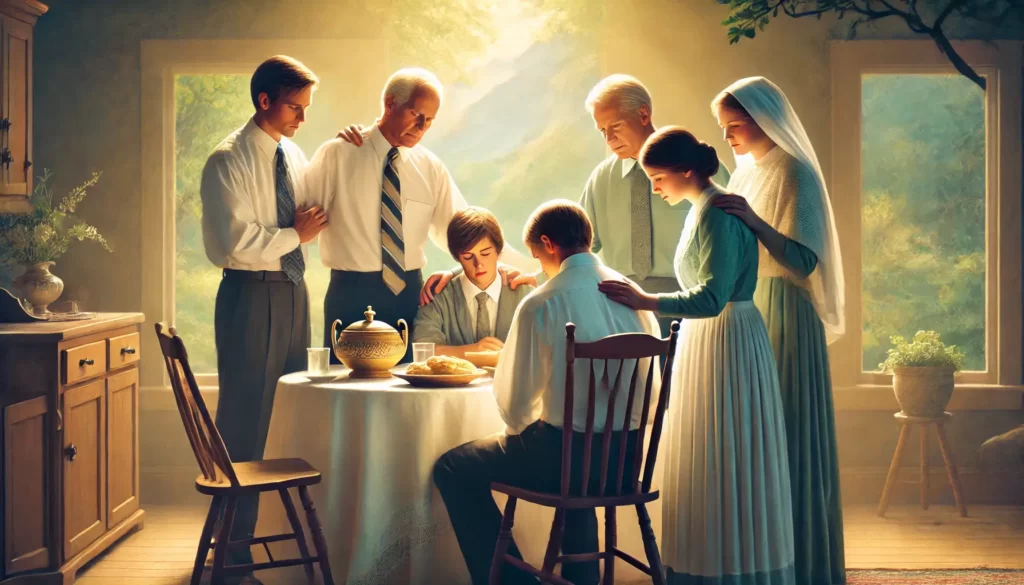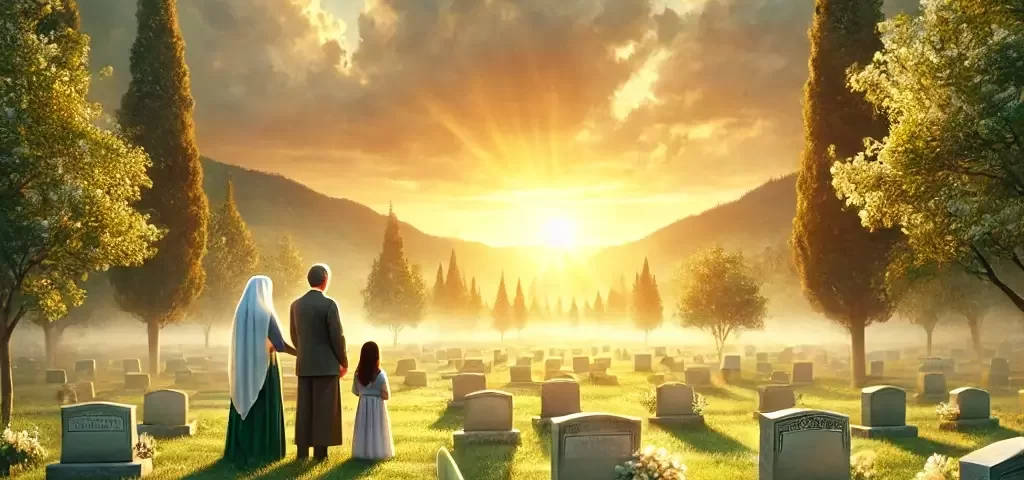Mormon Funeral Services

Muslim Funeral Traditions
March 11, 2025
Buddhist Funeral Traditions
March 24, 2025Funerals for Mormons are based in The Church of Jesus Christ of Latter-day Saints (LDS) doctrine and revolve around eternal life, faith, and family. Mortality is a continuation rather than cessation, and the soul persists with its existence into the next phase of existence in the hereafter. A funeral is a recognition of the one who died, as well as a recital of foundational teachings of LDS for resurrection and family that never end.
Overview of LDS (Mormon) Beliefs About Death and the Afterlife
Mormons believe in life after death. The spirit departs from the body after death, LDS doctrine instructs, and goes to the Spirit World, where resurrection preparation and learning continue. The ultimate goal is to return to live with loved ones in the presence of God. Funeral services reflect this belief, comforting by bearing scriptures and testimonies that teach about eternal life.
Importance of Funeral Services in the Mormon Faith
Mormon funerals are a time to enable family and friends, as well as the church community, to provide support and to declare faith. They emphasize the celebration of the life of the deceased while affirming the LDS belief in eternal families. In contrast to most other Christian funerals that focus on loss and sorrow, Mormon services emphasize hope, reunion, and divine purpose.
How Mormon Funerals Differ From Traditional Christian Funerals
While mourning is emphasized by the conventional Christian funeral, Mormon funerals keep its message and sense of appreciation and hope alive in religion. Prayers, hymns, and eulogies are presented in the form of words of eternal life rather than agony or loss. Secondly, no sacraments are provided during the Mormon funeral like Holy Communion but they include the teaching from the Bible and Book of Mormon and thought-provoking words by the family as well as even the leaders of the church.
Key Elements of a Mormon Funeral
Purpose of a Mormon Funeral
Focus on Faith, Family, and the Afterlife
Mormon funerals affirm the practice of eternal life and the continuity of the continuation of the soul’s journey. They offer solace through the reading of scriptures, personal testaments, and church hymns. Family and community support become the focal points, making the grieving feel comforted by the presence of faith and love.
Remembering the Deceased While Emphasizing Eternal Life
Unlike secular or other religious funerals, LDS services balance personal memories with spiritual teachings. Speakers often share uplifting stories about the deceased, focusing on their faith and contributions to their family and church.
Funeral Location & Setting
Typically Held in an LDS Chapel or Funeral Home
Most Mormon funerals take place in an LDS chapel or funeral home. The chapel provides a space for worship and community gathering, ensuring a respectful and sacred atmosphere.
Not Conducted in Temples (Temples Are Reserved for Sacred Ceremonies)
LDS temples are reserved for ordinances such as marriages and baptisms for the deceased. Funerals are held in chapels or other locations to accommodate attendees of all faiths.
Structure of the Funeral Service
Opening Prayer
A member of the family or church offers a prayer to begin the service, inviting the presence of God to bring comfort and peace.
Hymns and Musical Performances
Mormon funerals place an important role for sacred music. God Be with You Till We Meet Again and I Know That My Redeemer Lives are popular hymns sung to comfort and reaffirm belief in the afterlife.
Eulogies by Family Members
Family members share personal stories and memories of the deceased. The focus remains on their faith, kindness, and contributions to the community.
Messages from Church Leaders
A message from LDS doctrine is given by a bishop or other church leader, offering spiritual comfort and reaffirming the resurrection and eternal families doctrine. A closing prayer and, sometimes, a final hymn precede the transition to the graveside service to conclude the funeral service.
Mormon Burial & Cremation Beliefs
Preference for Traditional Burial
LDS doctrine focuses on the sanctity of the body, such that traditional burial is highly preferred. Leaders of the Church promote burial as the means to provide dignity to the physical body that the spirit inhabited. Burial conforms to notions of resurrection, whereby the spirit and body are rejoined together in the hereafter.
Views on Cremation and Exceptions
While burial is favored, cremation is not out of the question. Where legal or economically inevitable, LDS brethren may still obtain a funeral ceremony and religious sacraments. Members are usually counselled by general church leaders and local bishops for guidance on handling cremation cases.
Dress Code for Burial (Temple Garments for Endowed Members)
Members of the LDS Church who have been endowed in temples are usually buried in holy temple garments. They represent their devotion to faith and their Godly covenants. Family members cooperate with funeral directors and dress them properly before burial in order to maintain religious traditions and practices.
Mourning & Grief in the LDS Community
The Importance of Community Support
Mormons observe the practice of comfort through community service. Wards gather to assist in comforting grieving families with food, assistance in funeral arrangements, and emotional comfort. The religious community plays a crucial role in ensuring that no family grieves alone.
How Mormons Comfort the Grieving Family
Sympathetic expressions are very practical in this regard, meaning doing service rather than manifesting abounded grief. Mealtimes may be catered for, childcare and mundane chores thus freeing the grieving family to heal. Themed on faith, a LDS may instruct a mournful congregant to pray rather than linger over grief periods.
Beliefs About the Resurrection and Eternal Families
One of the core teachings in Mormonism is that families will be reunited in the hereafter. This is comforting to those who are mourning a loss. Social support and funeral eulogies focus on the promise of resurrection, reinforcing belief in eternal bonds and not focusing on grief.

Mormon Funeral Etiquette: What to Expect
Dress Code: Modest Attire (Dark, Formal Clothing)
Guests can dress in modest, formal attire, usually dark or neutral colors. Men dress in dress shirts and ties or suits, while females dress in dresses or skirts that fall below the shoulders and knees. The dress should be dignified, not with bright colors or casual clothes.
How to Show Respect: Participating in Prayers and Hymns
Mormon funerals will typically have prayers, hymns, and scripture readings. Joining in is encouraged but not required for non-Mormons. Not saying anything, standing when necessary, and listening are all respectful things to do at the service and mourning family.
Role of Non-Mormons: Attending the Service and Expressing Condolences
A Mormon funeral is an open-casket procedure. Non-Mormons are welcome to attend the funeral and can participate in general decency. Words of condolence can be offered by providing condolences, sending flowers, or writing a heartfelt note. Traditional visitations and wakes are not followed but may be extended to the reception after the service, typically including a commensal meal.
Post-Funeral Traditions
Family Meal or Gathering After the Funeral
After the funeral service, loved ones and family members come together for a meal, usually served at a house or church facility. The meal is a chance to reminisce, provide encouragement, and unite the community further. This tradition is indicative of the significance of unity in healing.
Graveside Service & Final Prayers
The funeral most often is a graveside ceremony in which the casket has a church member or family spokesperson offer a prayer. There may be flowers laid on the coffin or softly spoken words among attendees. It is dignified yet a proclamation of resurrection faith and forever-bound families.
Annual Remembrance Practices
Mormon families usually memorialize their dead with annual memorial activities. These may be anything from graveyard visits to special family prayers or story-telling sessions of remembrance. Others choose to memorialize their loved ones by service acts, such as volunteerism or donations in their name, affirming LDS values of faith and charity.
Modern Adaptations of Mormon Funerals
Live-Streamed Services for Distant Family Members
With families tending to be geographically dispersed, live-streamed funerals have become increasingly popular. This adjustment enables those who cannot be physically present to join in, keeping the community-oriented aspect of LDS funerals intact. Most church chapels are set up to accommodate virtual attendance, making everyone feel included.
Non-Traditional Funeral Venues and Personalized Memorials
Although chapels are still the first choice, a few families use other facilities like outdoor places or community halls. Customized memorials such as video testimonies and tailor-made programs are also becoming more popular. Such details offer an authentic means to honor the individual’s life without deviating from LDS teachings.
Conclusion
Mormon funeral traditions emphasize faith, family, and the immortality of the soul. Services are based on remembrance while reaffirming the resurrection promise. Post-funeral traditions, including family meals and annual memorials, provide ongoing solace for grieving loved ones.
With the changing times, some alternatives have been developed, including live-streamed worship and unconventional locations. Still, the traditional practices of paying respect to the deceased, comforting the family, and celebrating forever families have not changed. Respecting a Mormon funeral and showing comfort in a manner compatible with LDS doctrine reinforces the ties of faith and unity.


